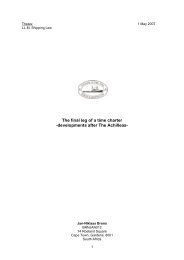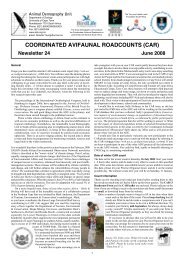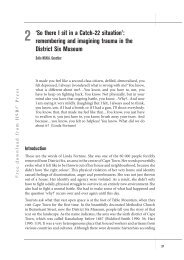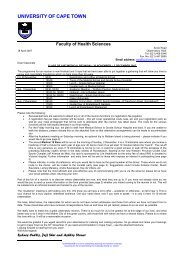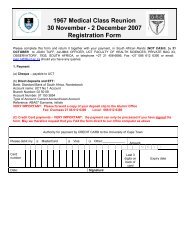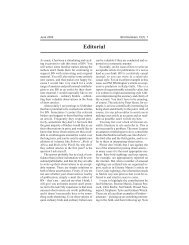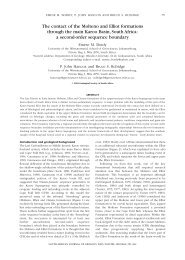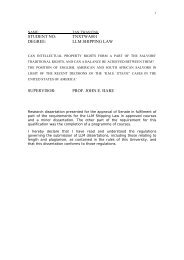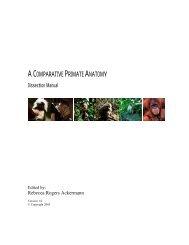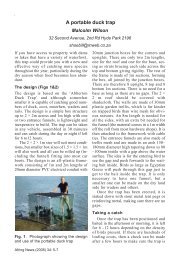insanity.pdf
insanity.pdf
insanity.pdf
You also want an ePaper? Increase the reach of your titles
YUMPU automatically turns print PDFs into web optimized ePapers that Google loves.
Africa 15<br />
An example of the way in which expert testimony has been adduced in this<br />
defence, is that of spousal homicide. Theron du Toit draws on the work of<br />
Hoffman and Zeffert (1988) by saying that ‘[t]he opinion of expert witnesses<br />
is admissible whenever, by reason of their special knowledge or skill, they are<br />
better qualified to draw inferences than the court. The admissibility of the<br />
evidence of expert witnesses is furthermore governed by the relevance of that<br />
evidence’ (1993, p. 247). She says that developments within case law<br />
regarding spousal homicide have pointed to the need for psychiatric or<br />
psychological evidence in ascertaining criminal responsibility. In the case of S<br />
v Campher 1987 (1) SA 940 (A), the court acknowledged this need and<br />
consequently expert testimony regarding battered woman syndrome was<br />
considered to be relevant and admissible. However, as cases such as S v Wiid<br />
1990 (1) SACR 561 (A) have shown, expert testimony is not indispensable,<br />
particularly when a factual foundation for non-responsibility has been laid in<br />
evidence. The result is that the onus is on the State to prove that the accused<br />
was criminally responsible. When a factual foundation has been laid, expert<br />
testimony may serve the purpose of facilitating this process but in the final<br />
analysis, it may well be superfluous (Theron du Toit, 1993). This antithetical<br />
situation highlights the difficulties which arise in defences which fall within<br />
the ambit of non-pathological incapacity. On one hand, expert testimony<br />
serves the purpose of outlining the psychological factors which lead to nonresponsibility.<br />
On the other, expert testimony is not required by law because<br />
the court may be in a position to make a finding based solely on the factual<br />
evidence (Van Oosten, 1993).<br />
Case example 8.3: Can rage impair conative functioning?<br />
In S v Moses 1996 (1) SACR 701 (C), the accused was charged with the murder of his lover. On the day<br />
in question, the accused and the deceased had unprotected intercourse after which the deceased declared<br />
that he had AIDS. The accused testified that he became enraged at hearing this and went to find an<br />
ornament with which he struck the deceased twice on his head. He then went to the kitchen to get a<br />
small knife and stabbed the deceased in the side. He returned to the kitchen to find a big knife with which<br />
he slit the deceased’s throat and wrists. The accused testified that he was overwhelmed with hatred for<br />
the deceased and he felt that his trust had been abused. It also reminded him of the sexual abuse which he<br />
had suffered at the hands of his father. His mind was flooded with thoughts as to how he would break the<br />
news of being HIV positive to his family and he also feared dying a horrible death. He testified that he<br />
was aware of what he was doing but was unable to control his actions because he was so enraged. In<br />
support of the defence of non-pathological incapacity resulting from extreme provocation, the defence<br />
led psychiatric and psychological evidence. This evidence focused on the accused’s psychosocial history<br />
which included sexual abuse, domestic violence and depression. He was diagnosed with borderline<br />
personality disorder and it was argued that he had manifested various neurotic behaviours such as head<br />
banging, bedwetting and fear of the dark, in childhood. This psychiatric ‘picture’ of the accused was<br />
coupled with a psychological ‘picture’ which traced a pattern of poor impulse control. It was argued that<br />
he was prone to anger and outbursts of violence and that he had exhibited rage reactions whenever he<br />
was provoked. The defence argued that given the accused’s personality structure and poor impulse<br />
control, his conative ability was impaired. He was therefore unable to control himself even though he<br />
was cognitively aware of his actions. In contrast, the state led rebuttal evidence in which the psychiatrist<br />
argued that a person’s conative functioning can only be impaired in sane automatism or other<br />
pathological states. It was argued that the accused did not act in an involuntary or automatic manner and<br />
that his actions were goal-directed and guided by conscious thought. He therefore had the cognitive<br />
capacity to distinguish right from wrong. The accused did not exhibit any signs of dissociative amnesia




